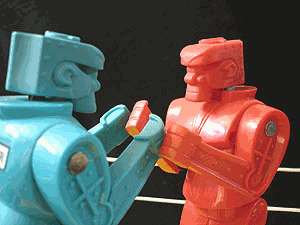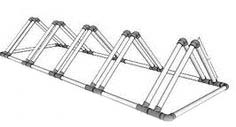
Wing Chun Mind: Fundamental Concepts
April 08, 2021
“In Wing Chun if you throw two fast punches to someone’s head they’ll be knocked out. The first punch causes the brain to go to one side of the skull . If a quick second hit comes, the person is knocked out. If you withdraw the hand to give the second punch, then the brain can recover (will have more time to recover), but if you don’t give this time then a knockout results.”
Wong Shun Leung, quoted in Global Wing Chun from a 1990 Seminar
This is a draft of a chapter for my “book-in-progress” Wing Chun Mind (see sidebar).
Hit Them in the Head
 What is the strategy of Wing Chun? We hit them in the head. Say that over and over a hundred times. Hit them in the head. Hit them in the head.
What is the strategy of Wing Chun? We hit them in the head. Say that over and over a hundred times. Hit them in the head. Hit them in the head.
The Rock’em Sock’em Robots had the right idea.
This is the principal concept and strategy of Wing Chun.
All around and behind this idea are supporting ideas – ideas that follow from this central principle. As Wong Shun Leung said in his quote, we really want to hit the opponent in the head in quick succession, with enough force in each punch to accomplish the goal, which is a knockout. OK – how do you do that? This is what the rest of the system teaches you. And if you think it through, there are all sorts of other questions that come to mind. How do I keep from getting hit while I’m trying to hit them ? What if they tackle me? What if they grab my arms? Etc. It’s all in the system. They pretty much thought of everything. This is why its called a “complete” system.
How can you develop this capability? You want to be able to knock them out, while not getting hurt, and ideally, using training in which you also don’t get hurt. I’m studying this so I don’t get hurt. There is no 100% guarantee (accidents happen) but this is a goal I think was shared by our Wing Chun ancestors – this is why they invented Chi Sao.
Wing Chun was thought through by some very smart people, and then a bunch of other smart people tried it out and refined it. Sifu Gary Lam said “Wing Chun makes you smarter.” This what I think he meant. To understand it, it helps to think through the choices made by the architects of the system.
So our goal is to hit them in the head with the right amount of force in the right spot in quick succession while avoiding being hit back. Wing Chun figured out a way to accomplish this, a way that is a simple idea, yet complicated to develop as a skill. It is a clear and simple idea and in order to do it, you have to keep reminding yourself over and over again – “keep it simple.” “Hit the head.” Ask every time you train – how does what I’m doing here support the goal to hit the head?
Everything in the system supports this goal. When I say “everything in the system,” what do I mean? What’s in the system? Let me do a short list here of the main ideas. I’ll go into each of these ideas in detail later in this series, but let’s just list them first.
Chase center.
Take position.
Don’t take the hand back.
Lat Sau Jek Cheung, Loi Lau Hoi Sung (receive what comes, follow what goes, upon loss of contact, rush in). This crucially important but hard to understand and even harder to get your body to do reflexively.
Attack according to timing – timing is achieved through practice.
Understand structure. Learn to maintain yours and undermine theirs.
The body follows the hands (when unarmed).
Control the centerline.
To win in an instant is a superior achievement.
The application of techniques will vary according to the opponent.
Seek a bridge.
Two hands control one.
Make the opponent “wrong” by shifting their “facing” or changing your own facing.
Take away the opponent’s balance.
Unknown techniques are not suitable for training practice.
Geng ging or animal nature. This is difficult to tap for a good-natured person.
PS I think most of these were captured a hundred years ago or more in what we call the Wing Chun Kuen Kuit , or Wing Chun Songs. These were (I hear rhymed) little snippets in Cantonese which captured this knowledge for future generations (like us!).
To all of this I add something I think is implied but not explicitly stated, but we find alluded to a lot and we find explicitly described by folks like Miyamoto Musashi and Geoff Thompson . In life or death situations, be prepared for subterfuge and use subterfuge. Don’t rule out the sucker punch. Let’s take a quick look at some of the other supporting ideas.
The Best Defense is Offence
Everything in the system supports the principle goal of hitting the opponent in the head. What is our defense? We attack the head. If you attack someone’s head who is attacking you, they will be forced to break off their attack to defend themselves. Try it! When someone swings at you, step in and start firing punches at their head. They will step back or put their hands out or both, unless they are skilled, in which case they may angle off and stay in range. This is generally what you want to do also, if someone attacks your head. Bridge/angle/counter-punch. More on these later.
How Do You Hit With the Right Amount of Force?
Wing Chun (like old school boxers from the late 1800s and early 1900s) generates power partially by getting the weight of the body into the punch. We also use the power of the ground. We do this by combining structure (skeletal alignment aka ground power) and stepping (taking position). This is a complicated subject and takes a long time to learn and to do instinctually. It doesn’t take that long to learn how Wing Chun works, if you have a knowledgeable teacher, but it does take a long time to get it in your body , or make it instinctive . It will work best if it becomes an instinct or a reflex. This takes time.
What is Structure?
I did a little video a while back which demonstrates a very simple version of structure from a simple angle:
As you can see, my elbow is down and it has a “relationship” with my hip. If you do this yourself and have someone lean their weight into your fist, you will feel that there is a structured relationship starting at the impact point of the fist (the pinky and ring finger), traveling through the wrist into the forearm (along the radius and ulna bones). Due to the engineering and how force works in structures, the force is received by the structure that is a combination of the upper arm (humerus) and practically the entire upper skeleton (scapulae, spine, etc) when held into the right position.
This “lined up” position effectively transfers the weight of the partner leaning into the fist into your hip, down your leg, and into your heel. This line of power we call “ground power.” You are directing the force applied at the fist down through your body through what Sifu Lam calls “power points” (wrist, elbow, knee, ankle). The power flows through if the joints are not locked. You have to be slightly loose or relaxed. Not tense. This allows the weight flow down into the ground, or looked at from the other direction, allows the ground power to come up through your body into the point of contact (ideally, the opponent’s head). My friend Buka weighed around 250 at that time. I can hold him like that easily. I often liken this to sticking a broom handle into the ground at a 45 degree angle. Or a bicycle rack. The concepts are the same. Force going in one end is transmitted into the ground and you end up pushing the ground, which won’t move (usually).


This is easy to demonstrate in this simple experiment. Of course, in a real fight, with the heart pumping and adrenaline flowing and the brain in a somewhat debilitating “fight mode,” (including possibly such effects as tunnel vision, time distortions, etc) and with the opponent(s) not sitting still and endangering you and yours, its a lot less simple. So in training, we work on learning to move around with our guard up, staying relaxed, firing our arms toward the opponents, and being able to “find” structure at (or just slightly before) the impact. But the relaxation, ideally, is not lost! You don’t want to “tense up” and you don’t have to. You can deliver a shocking, grounded, whippy kind of force into the target. Two or three at a time, in quick succession, in fact.
And all of this is done from the “bridge.”
What is a bridge?
More on that in the next chapter.